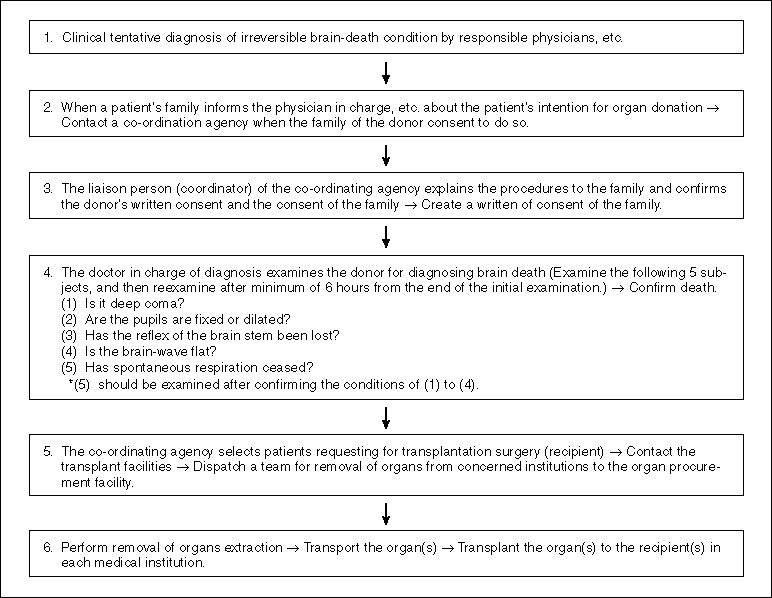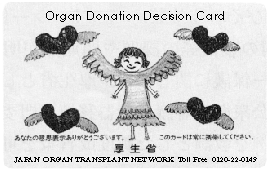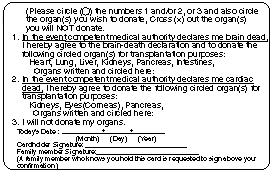
(1) Laws on organ transplantation
Based on the "Cornea Transplantation Law" established in 1958 and the "Cornea and Kidney Transplantation Law" established in 1979, transplantation of cornea and kidney from heart-dead donors have been performed in Japan. After vigorous debates on whether or not brain death should be considered as death of a person, and whether or not to permit transplantation of organ from brain-dead donors, organ transplantation is currently performed based on the "Organ Transplantation Law" (established in June 1997 and enforced in October 1997).
(2) Conditions after the enactment of the Organ Transplantation Law
In fiscal 1997, 166 cases of kidney transplantation and 1,748 cases of cornea transplantation were performed from heart-dead donors. The numbers of patients registered on the waiting list of co-ordinating agencies are 18 patients for heart, 31 patients for liver, 10 patients for lung, 13,119 patients for kidney (As of the end of May 1999, registered to the Japan Organ Transplant Network), and 5,542 patients for cornea (As of the end of April 1999, surveyed by the Japan Eye Bank Association).
Under such circumstances, on February 28, 1999, organs were donated from a brain-dead donor for the first time after the establishment of the Organ Transplantation Law, and through March 1, heart, liver, kidneys and corneas were transplanted, which marked the first foot-step into the new age for medical transplantation.
In this case, organ donation as well as removal, transportation and transplantation of organs were performed in collaboration with relevant members, and the event was reported widely as the first removal and transplantation of multiple organs including heart, liver, kidneys and corneas from a brain-dead donor in Japan.While the event gathered national attention, various problems were also raised. Some of the issues and problems revealed were how to secure the transparency in the medical practice of transplantation while protecting the privacy of the organ donor and his/her family, etc., and how to improve the system in co-ordinating agencies to select the patients requesting transplantation surgeries. The Ministry of Health and Welfare is particularly concerned about the issue of protecting the privacy of organ donors and their families.Including this issue, the Professional Committee on Organ Transplantation in the Council on Public Health and others are planning to inspect and verify various procedures in the cases and to formulate measures to improve the system based on the learning of this case as soon as possible.
Figure 3-4-1. Outline of the Flow of Organ Donation from a Brain-dead Donor

![]()

|
|

|
The second case of organ donation from a brain-dead donor was scheduled in May 1999, and this case will be reviewed in the same way as the previous case.
(3) Actions for promoting organ transplantation
In the U.S. and European nations, transplantation of hearts, lungs, etc. removed from brain-dead donors has been part of routine medical procedures and it has been contributing to the rescue of many patients.
In order to promote organ transplantation in Japan, it is essential to propagate correct knowledge of brain-death and organ transplantation, and to enlighten people first. For this purpose October of each year has been designated as "Kidney Transplantation Promotion Month" to promote enlightenment on kidney transplantation, and starting in 1999 the month is renamed to "Organ Transplantation Promotion Month (tentative name)" to enhance the enlightenment efforts.
According to the Organ Transplantation Law, the donor's written intention is required to perform brain-death diagnosis and removal of organs. Considering this law, the "Organ Donation Decision Card" is created and distributed with cooperation of municipalities, prefectural police offices, post offices, etc. In order to provide multiple means to express one's intention about being a donor, the "Organ Donation Decision Label" is also created and distributed to be pasted on the medical insurance certificates, driver's license, etc.
In addition, comprehensive measures will be in place to develop and improve the system supported by organ procurement facilities, transplant facilities, Japan Organ Transplant Network, etc. for promoting medical transplantation that people can feel safe and reliable.
2. Measures against Intractable Diseases
(1) New directions for measures to combat intractable diseases
Japan has been taking actions for measures to combat intractable diseases centering on five principles:"promoting investigation and research", "providing medical care facilities", "eliminating co-payment for medical costs", "improving and coordinating community-based health care, medical care and welfare services", and "promoting welfare measures aimed at improving quality of life (QOL)".
Since initiating measures against intractable diseases, a quarter of century has passed. During that time medicine and medical care have advanced and great improvement has been made for some diseases in terms of prognosis and quality of life, but for some diseases effective symptomatic therapies are yet to be found, and such diseases are imposing heavy burden on patients' families due to the severe conditions. Actual situations vary greatly between diseases and individual patients.
Considering these changes, a decision was made to thoroughly review the current measures to combat intractable diseases during fiscal 1998 with the viewpoint of improving the measures for patients in serious conditions, and to revise the measures to focus on patients in serious conditions.
(2) Comprehensive promotion of measures to combat intractable diseases
Based on these principles, in fiscal 1999 we will promote comprehensive measures to combat intractable diseases with focus on patients in serious conditions.
Measures for patients in serious conditions will be improved and enhanced in various areas through following efforts: 1 promoting effective research on intractable diseases by expanding the range to invite public contributions in research projects, 2 facilitating model hospitals and supporting hospitals for intractable diseases in each prefecture to secure care facilities for the patients of intractable diseases in serious conditions, 3 effectively implementing following services with the leadership of health centers: in-home care support plan development and assessment services, home-visit consultation services, medical care consultation services, and home-visit guidance (medical examination) services, and 4 promoting in-home living support program for patients of intractable diseases who require in-home long-term care support such as home-visit care, short-stay, Daily Living Technical Aid, etc. Provision Program, etc.
For the specific disease treatment research program (public funding system for the expenditure of medical care for intractable diseases), the number of subject diseases was increased (addition of four diseases in fiscal 1998 (total 43 diseases)) and co-payment was introduced in May 1998 to the patients who are not in serious conditions (\2,000 per month per medical institution for outpatient, \14,000 per month for inpatient (including dietary therapy expense)) (For patients in serious conditions, public fund will continue to bear all co-payment portion in the medical insurance system.). As part of this program, home-visit nursing care treatment research program will be implemented for the patients using artificial respirator at home (260 times per year per patient) to support the study and research of patient care through home-visit nursing as well as for in-home long-term care.